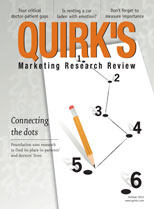Editor's note: Charlene Randall is director, business development, at L&E Research, Raleigh, N.C. She can be reached at crandall@leresearch.com. This article appeared in the October 22, 2012, edition of Quirk's e-newsletter.
Conducting interviews. Flying on planes. Observing focus groups. Fielding projects. If you are doing any number of these, chances are you may be putting yourself at risk by sitting more than you realize. Researchers now say, regardless of whether you exercise regularly, sitting too long too often can lead to a number of health problems and even premature death. It's important that you know the dangers involved in prolonged sitting and some easy tips you can follow to protect yourself.
According to a study from the Mayo Clinic, 50 to 70 percent of people spend six or more hours sitting each day. Every hour on a plane, in a car and behind your computer adds up. Dr. James A. Levine, a leading researcher on the health hazards of sitting too much, says, "Today, our bodies are breaking down from obesity, high blood pressure, diabetes, cancer, depression and the cascade of health ills and everyday malaise that come from what scientists have named sitting disease ... Every two hours spent just sitting reduces blood flow and lowers blood sugar, increasing the risk of obesity, diabetes and heart disease." Levine continues by saying if you've sat for an hour, you've probably sat too long.
Even if you exercised earlier that day, sitting for the length of a typical focus group is not good. It is imperative that we take breaks. "We've become so sedentary that 30 minutes a day at the gym may not counteract the detrimental effects of eight, nine or 10 hours of sitting," says Genevieve Healy.
Martha Grogan, a cardiologist at the Mayo Clinic, says, "For people who sit most of the day, their risk of heart attack is about the same as smoking."
Dangers of prolonged sitting
No one knows the dangers of prolonged sitting better than L&E Research's general manager Christine Conrad, who was diagnosed with a pulmonary emboli (blood clot in the lung) a few years ago. While Conrad is doing well today, it has been a wake-up call to all of us who sit at a computer.
Protect yourself
An Ipsos study reports that three-fourths of full-time employees of large companies wish they didn't spend most of their working hours sitting. Further, 67 percent of U.S. office workers wish their employers offered them desks that could be adjusted so they could work either seated or standing. Since exercise only helps a little and most of us don't have adjustable desks, here are some easy things you can do to protect yourself.
Phone calls: Each time your phone rings, stand up. If possible, pace while talking.
Meet and walk: Instead of sitting around a conference room table for the usual meeting, walk as you talk. If you need to talk with a colleague during work, walk to his/her desk instead of sending an e-mail.
Wall sits: Not only will these give your legs and back a break, they are great for building strength and endurance. Stand with your back against a flat wall. Bend your knees and slide your back down the wall until your thighs are parallel with the floor. Sit and hold for 30-60 seconds.
Set a timer: Be aware of how long you've been sitting. Conrad gave timers to L&E staff members along with instructions to set the timers for regular intervals so that we will remember to stretch our legs while working. Levine recommends when working at a computer that people should get up for 10 minutes every hour and stretch their legs. To stay productive, utilize this time for phone calls or anything that is best accomplished when moving.
Eat your lunch standing: As a bonus, you'll actually burn three times the number of calories you would have if you sat while eating.
Printer runs: Walk to the printer each time you print something instead of waiting to pick up your copies all at once.
Stand whenever you can: L&E offers our clients observation work space that allows them the option to work on their laptops and view activity in the focus group room all while standing.
Virtual relay: Since not all of our team at L&E Research works at the same location, we came up with a fun way to remind each other to take a break from sitting. Each morning an e-mail with a list of employees names is sent to our staff members. The person at the top of the list that day steps away from their desk for 10-30 minutes to stretch his/her legs and/or engage in some form of aerobic activity. We may walk around the office or run up and down steps. We've even been known to do a little kickboxing. When finished, the first teammate then passes the virtual baton to the next person on the team via a reply-to-all e-mail. That teammate then steps away from his or her desk, engages in their physical activity and passes the baton to the next teammate, all while being cheered on by the team. We continue this until every team member has had a chance. We remain flexible since there may be times when someone can't step away at that moment. But each day, each of our team gets a formal turn and is reminded throughout the day of the importance of taking regular breaks from sitting.
Be aware
Remember, even if you engage in aerobic activity each day, be cautious not to sit for long periods of time. The trick is to be aware, get up and take breaks often.
Now I'm passing the baton to you.
Sources
Mayo Clinic www.mayoclinic.com/health/sitting-disease/MY02177
JustStand.org www.juststand.org/tabid/674/default.aspx
Live Science www.livescience.com/18776-sitting-disease-smoking.html
